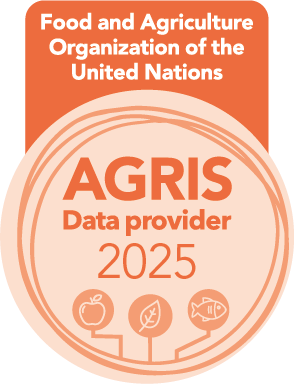

Address: Naberezhnaya Severnoy Dviny, 17, Arkhangelsk, 163002, Russian Federation, Northern (Arctic) Federal University named after M.V.Lomonosov, office 1425
Phone: +7 (8182) 21-61-18
E-mail: forest@narfu.ru
http://lesnoizhurnal.ru/en/
|
The Influence of the Cuttings Propagation Timing on the Rooting Ability of Cuttings of Some Willow Species in the Norilsk Industrial District. С. 52-62
|
 |
Varaksin G.S., Cherbakova N.N.
UDС
582.623.2:581.165.712:502.654
DOI:
10.37482/0536-1036-2025-3-52-62
Abstract
To create willow plantations in the Norilsk Industrial District, it is necessary to use planting material from the most resistant to man-made impact local willow species (Salix lanata L., S. hastata L. and S. viminalis L.) using the cuttings method. Obtaining the best results of rooting cuttings in the open and covered ground in the conditions of the Norilsk Industrial District is possible if the optimal timing of their cutting is observed, which should coincide with the period of readiness of the shoots of the maternal plant to form roots, as well as when certain conditions are created for growing plants (temperature-humidity and lighting conditions, the presence of a nutrient soil mixture, treatment of cuttings with a rooting preparation). The timing of cuttings propagation is considered and determined taking into account weather conditions, phenophases of development of maternal plants and the influence of the listed factors on the rooting process. The optimal timing can be considered to be the periods starting from the moment of bud swelling and ending with the entry of maternal plants into the active growth phase (from the first 10 days of June till the first 10 days of July). Harvesting cuttings of species of the genus Salix at this time has contributed to the success of their rooting and survival. High rooting results in both types of ground have been recorded in 2023 for the species S. viminalis L. (51–87 %) and S. hastata L. (48–82 %) during the period of the beginning of leaf growth and intensive plant development; slightly lower, under the same conditions, have been the indicators for S. lanata L. (41–74 %). It is important to emphasize that for the studied willow species, no significant differences in the rooting process of cuttings have been identified. Analysis of the results of the rooting of cuttings of various willow species allows us to conclude that it is advisable to further use them as planting material in this natural area. The data obtained can serve as a basis for the development of a technology for growing willow cuttings in arctic conditions and be applied in the planning of reclamation and landscaping of urban facilities in the Norilsk Industrial District.
Affiliation
1Sukachev Institute of Forest of the Siberian Branch of the RAS – Division of Federal Research Center “Krasnoyarsk Scientific Center of the Siberian Branch of the RAS”, Akademgorodok, 50/28, Krasnoyarsk, 660036, Russian Federation; varaksings@mail.ru*
2Research Institute of Agriculture and Ecology of the Arctic – Branch of Federal Research Center “Krasnoyarsk Science Center of the Siberian Branch of the Russian Academy of Sciences”, ul. Komsomolskaya, 1, Norilsk, 663302, Russian Federation; natalya.ochikolova@mail.ru
Keywordsarctic conditions, willows, open and covered ground, cuttings propagation timing, technogenically disturbed lands, rooting of cuttings, the Norilsk Industrial District
For citation
Varaksin G.S., Cherbakova N.N. The Influence of the Cuttings Propagation Timing on the Rooting Ability of Cuttings of Some Willow Species in the Norilsk Industrial District. Lesnoy Zhurnal = Russian Forestry Journal, 2025, no. 3, pp. 52–62. (In Russ.). https://doi.org/10.37482/0536-1036-52-62
References
- Antsiferov G.I. Willow. Moscow, Lesnaya promyshlennost’ Publ., 1984. 101 p. (In Russ.).
- Weather Archive for Norilsk. (In Russ.). https://rp5.ru/Архив_погоды_в_Норильске
- Afonin A.A. Development Dynamics of the Almond Willow’s Shoots on Different Levels Atmospheric Moisture. Lesovedenie = Russian Journal of Forest Science, 2023, no. 1, pp. 44–51. (In Russ.). https://doi.org/10.31857/S0024114823010023
- Valyagina-Malyutina E.T. Willows of the European part of Russia: Illustrated Guide. Moscow, KMK Scientific Press Ltd., 2004. 217 p. (In Russ.).
- Varaksin G.S., Antonenko S.N. Phenological Features of Shrubby Willow Species in the Vicinity of Norilsk. Proceedings of the All-Russian Conference Dedicated to the 60th Anniversary of the V.N. Sukachev Institute of Forest (Siberian Branch of the Russian Academy of Sciences) and the 70th Anniversary of the Krasnoyarsk Region. Krasnoyarsk, Institute of Forest (Siberian Branch of the Russian Academy of Sciences), 2004. 491 p. (In Russ.).
- Varaksin G.S., Kuznescova G.V. Specifics of Biological Recultivation in Norilsk Industrial Region. Sibirskij lesnoj zhurnal = Siberian Journal of Forest Science, 2016, no. 2, pp. 92–101. (In Russ.). https://doi.org/10.15372/SJFS20160209
- Varaksin G.S., Kuznetsova G.V., Evgrafova S.Yu., Shapchenkova O.A. Biological Recultivation of Technogenic Landscapes in Norilsk Industrial Region. Sibirskij ekologicheskij zhurnal = Contemporary Problems of Ecology, 2014, no. 6, pp. 1039–1047. (In Russ.).
- Vekhov N.K., Il’in M.P. Vegetative Propagation of Woody Plants by Summer Cuttings. Leningrad, N.I. Vavilov All-Russian Institute of Plant Genetic Resources (VIR) Publ., 1934. 284 p. (In Russ.).
- Heteroauxin: Instructions. (In Russ.). https://edelstarus.ru/udobreniya/200-geteroauksin-instrukcija-po-primeneniju-stimuljatora-rosta-otzy...
- Granitsa Yu.V., Sokolova N.A., Lezhnin K.T. Growing Planting Material in a Tree Nursery of Ornamental Plants: Course of Lectures. Yoshkar-Ola, Volga State University of Technology Publ., 2012. 236 p. (In Russ.).
- Dospekhov B.A. Field Experiment Methodology (with the Basics of Statistical Processing of Research Results). Moscow, Agropromizdat Publ., 1985. 351 p. (In Russ.).
- Epanchintseva O.V., Tishkina E.A., Montile A.A. Features of Growth and Development in the First Years of Growing Various Taxa of Genus Salix L. in the Urbanized Territory of Ekaterinburg. Vestnik Buryatskoj gosudarstvennoj sel’skokhozyajstvennoj akademii imeni V.P. Filippova = Vestnik of Buryat State Academy of Agriculture named after V. Philippov, 2021, no. 3 (64), pp. 83–91. (In Russ.). https://doi.org/10.34655/bgsha.2021.64.3.011
- Zakharova L.A. Resistance of Species of the Genus Salix L. to Aerotechnogenic Atmospheric Pollution: Cand. Biol. Sci. Diss. Abs. Novosibirsk, 2005. 176 p. (In Russ.).
- Komissarov D.A. Biological Principles of Propagation of Woody Plants by Cuttings. Moscow, Lesnaya promyshlennost’ Publ., 1964. 291 p. (In Russ.).
- Kulagin A.Yu. Biological Characteristics of Some Willow Species in Technogenic Habitats of the Cis-Urals and Southern Urals: Cand. Biol. Sci. Diss. Abs. Tomsk, 1983. 19 p. (In Russ.).
- Kulagin A.Yu. Willows: Technogenesis and Problems of Optimization of Disturbed Landscapes. Ufa, Gilem Publ., 1998. 193 p. (In Russ.).
- Martynova N.A., Tokhtar’ V.K. Some Approaches to Directed Selection of Species at Stable Agrophytocoenosis Creation in Anthropogenously Transformed Ecotopes. Nauchnye vedomosti Belgorodskogo universiteta. Seriya: Estestvennye nauki = Belgorod State University Scientific Bulletin. Series: Natural Sciences, 2011, no. 9 (104), iss. 15/1, pp. 308–312. (In Russ.).
- Morozov I.R. Willows of the USSR, Their Use and Application in Protective Afforestation. Moscow – Leningrad.Goslesbumizdat, 1950. 168 p. (In Russ.).
- Novitskaya G.N. Cuttings of Shrubs. Tsvetovodstvo = Floriculture, 2013, no. 1, pp. 3–6. (In Russ.).
- Pakhov A.S. Phenology of Alluvial Willow Species in the Conditions of the Northern Dvina River Delta. Monitoring of the State and Pollution of the Environment. Main Results and Development Paths: Scientific Conference Abstracts of the All-Russian Scientific Conference. Moscow, Federal State Budgetary Institution “Yu.A. Izrael Institute of Global Climate and Ecology of the Roshydromet and the Russian Academy of Sciences, 2017, pp. 408–409. (In Russ.).
- Polikarpova F.Ya., Pilyugina V.V. Growing Planting Material by Green Cuttings. Moscow, Rosagropromizdat Publ., 1991. 96 p. (In Russ.).
- Polyakov A.A. Forest Reclamation of Lands in Taimyr and Norilsk Industrial Region as a Component of Biological Reclamation. Biological Resources of Taimyr and Prospects for Their Use: Proceedings of the International Scientific and Practical Conference.: Collection of Scientific Papers. St. Petersburg, Asterion Publ., 2003, pp. 183–186. (In Russ.).
- Polyakov A.P. Shelterbelts at the Yamal Agricultural Experimental Station: Bulletin of NTI. Leningrad, Research Institute of Agriculture and Ecology of the Arctic, 1957, no. 2, pp. 44–46. (In Russ.).
- Pospelova E.B., Pospelov I.N. Flora of Vascular Plants of Taimyr and Adjacent Territories. Moscow, KMK Scientific Press Ltd., 2007, part 1. 457 p. (In Russ.).
- Savchenko V.A., Novitskij M.A. Modern Climate of Norilsk. Moscow, GART Publ., 2003. 168 p. (In Russ.).
- Telyatnikov M.Yu., Pristyazhnyuk S.A. Anthropogenous Influence of Norilsk Industrial Area on Plant Vegetation Cover of the Tundra and Forest Tundra. Sibirskij ekologicheskij zhurnal = Contemporary Problems of Ecology, 2014, vol. 7, pp. 654–668. https://doi.org/10.1134/S1995425514060158
- Turetskaya R.Kh., Polikarpova F.Ya. Vegetative Propagation of Plants using Growth Stimulants. Moscow, Nauka Publ., 1968. 290 p. (In Russ.).
- Cherbakova N.N., Varaksin G.S. Timing of Cuttings of Some Willow Species in the Norilsk Industrial Region. Plodovodstvo, semenovodstvo, introduktsiya drevesnykh rastenij: Materialy XXVI Mezhdunarodnoj nauchnoj konferentsii = Gardening, Seed Growing, Introduction of Woody Plants: Materials of the XXVI International Scientific Conference, 2023, pp. 207–211. (In Russ.).
- Cherbakova N.N., Varaksin G.S. Characterization of the Genus Salix and Peculiarities of Phenological Development of Some Species in the Norilsk Industrial Region. Khvoinye boreal’noi zony = Conifers of the boreal area, 2024, vol. XLII, no. 1, pp. 43–50. (In Russ.). https://doi.org/10.53374/1993-0135-2024-1-43-50
- Chuprova I.L. Optimization of Technogenic Landscapes of the Far North (Norilsk Industrial Region, Taimyr Peninsula): doc. biol. sci. diss. abs. Petrozavodsk, 2006. 59 p. (In Russ.).
- Yanchenko Z.A., Cherbakova N.N. Assessment of Organomineral Resources for the Reclamation of Taimyr. Nauka i tekhnologii Sibiri, 2024, no. 4 (15), pp. 108–110. (In Russ.).
- Haissig B.E. Influences of Auxins and Auxin Synergists on Adventitious Root Primordium Initiation and Development. New Zealand Journal of Forestry Science, 1974, vol. 4, no. 2, pp. 311–323.
- Harayama H., Uemura A., Utsugi H., Han Q., Kitao M., Maruyama Y., The Effects of Weather, Harvest Frequency, and Rotation Number on Yield of Short Rotation Coppice Willow over 10 Years in Northern Japan. Biomass and Bioenergy, 2020, vol. 142, art. no. 105797. https://doi.org/10.1016/j.biombioe.2020.105797
- Keita N., Bourgeois B., Evette A., Tisserant M., González E., Breton V., Goulet C., Poulin M. Growth Response of Cuttings to Drought and Intermittent Flooding for Three Salix Species and Implications for Riverbank Soil Bioengineering. Environmental Management, 2021, vol. 67, pp. 1137–1144. https://doi.org/10.1007/s00267-021-01444-3
- Ma X., Pang Z., Wu J., Zhang G., Dai Y., Zou J., Kan H. Seasonal Pattern of Stem Radial Growth of Salix matsudana and its Response to Climatic and Soil Factors in a Semi-Arid Area of North China. Global Ecology and Conservation, 2021, vol. 28, art. no. e01701. https://doi.org/10.1016/j.gecco.2021.e01701
|
Make a Submission


Lesnoy Zhurnal (Russian Forestry Journal) was awarded the "Seal of Recognition for Active Data Provider of the Year 2025"

|







